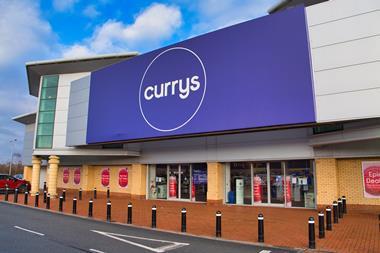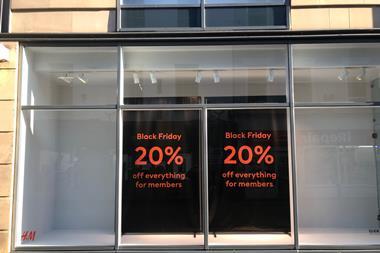A month ago Asda chief operating officer Andy Clarke caused a stir in Retail Week by saying there was no place for loyalty cards in retail. Here, in an extract from his new book, Martin Hayward of Dunnhumby, the company behind Tesco’s successful Clubcard, explains why he believes customer insight programmes are vital.

In today’s world of globalisation, efficiency and standardisation, it’s difficult to imagine how a giant retailer might be able to begin to offer the kind of personalised customer service
that we get from our local corner shop. Yet this is one of the most significant benefits for customers who belong to loyalty schemes.
Tesco’s Finest brand was launched using the insight drawn from Clubcard. It told them that there was a sizeable and significant group of customers who would be prepared to pay a little more for premium products. It was another example of Tesco wanting to grow the share of existing customer spend rather than hunt out new ones.
These customers did most of their shopping at Tesco but visited Waitrose or Marks & Spencer for special treats or at Christmas. Today, the Tesco Finest brand is bigger than Coca-
Cola in the UK in sales value. Interestingly, Tesco data shows how eclectic shoppers can be. Premium customers might buy the best muesli and value toilet roll.
Tesco’s ethnic range, World Foods, was launched following the analysis of customer data in a town with a large proportion of ethnic minorities. In this particular store the Tesco shoppers were not buying full meals, preferring to buy staples like huge sacks of rice, canisters of oil and loose bunches of herbs from local markets.
Tesco decided to build a superstore to appeal to the ethnic groups in the area. When the new store opened in 2005 it offered 800 different foreign products, up from 150 in the previous store. It also has a Halal butcher, newspapers in Arabic, Urdu, Punjabi and Bengali as well as a jewellery counter.
The World Food range has since been extended to many more stores, as analysis revealed that upscale white shoppers accounted for one quarter of World Food sales in this store. Today, Tesco’s store in Bar Hill, an affluent village near Cambridge, is one of the top sellers of the World Food range.
Keeping track
Rigorous, clever analysis of customers helps retailers offer a more bespoke experience to customers. It helps remove the headaches from shopping, making choices easier.
For example, interpreting US supermarket chain Kroger’s data showed that a customer’s first decision-making process when buying coffee was whether it was caffeinated or decaffeinated. It wasn’t about brand, it wasn’t about fair trade – it was just a simple either/or choice. So Kroger reorganised the way its coffee products were laid out on the shelves, dividing coffee into caffeinated and decaffeinated.
It sounds so simple but it was an important decision because it was led by customers – not the category manager, not a coffee brand, but the customer. A category manager might have wanted a top-selling brand to dominate the shelves, whereas a coffee brand manager would want all the different products grouped together to make more impact.
On a much bigger scale, customer data enables supermarkets to stock the products they know their loyal customers like and need. Most retailers looking to streamline their shelf space will just consider the lowest-selling items. Some of their loyal customers might value these niche products and there is a danger that if they remove an item there will be no viable alternatives.
For example, in the bread aisle in Tesco, a product like milk loaf may not be a big seller but it is a crucial item to keep in stock. This is because the customers who buy milk loaf do not want a substitute; if milk loaf is not there, they will go elsewhere to find it.
Retailers need to understand the difference between key products and substitutable items. While some items can always be substituted with an agreeable alternative, some key products cannot be replaced. If a retailer does not ensure these valuable, niche products are in stock, they will lose some of their customers.
Kroger is another good example of how a customer strategy can ensure valuable customers can buy the products they really want. We analysed some data on “yellow fats” – products like margarine, butter and vegetable spreads. By analysing the data, we were available to make a series of recommendations about a number of products Kroger could remove from the shelves without annoying its loyal customers, making sure that customers had an option to buy an alternative and also that Kroger’s most valuable customers would not be disgruntled by the changes.
Then we were called by Kroger management who were dismayed by a huge number of customers complaining about the changes. It turned out that Kroger had accidentally removed one of the products Dunnhumby had said was essential to keep. It was the only margarine in their range suitable for Jewish customers, so no surprise there was uproar. The customer data had revealed how crucial this product was to a critical group of Kroger shoppers.
Know your customer
Customer-focused businesses are different. They think about things in a different way. They don’t just look at low-selling items but at what their customers buy. They make sure they don’t de-list items that are valuable to them.
A helpful analogy involves Christmas. When you buy Christmas presents, isn’t it easier to buy presents for the people closest to you than distant relatives? The more you know, the easier it is. It’s the same for retailers that use customer data, by analysing what their customers like and don’t like, decisions become simpler. Customer data and insight informs and empowers decision making.
One customer might start shopping elsewhere if their favourite supermarket doesn’t stock organic bread. For another customer, the deal breaker might be a well-stocked fresh fish counter or a gluten-free range. Customer-focused retailers make sure they use their knowledge and insight to listen to what customers want.
It’s much simpler being a price discounter. They only worry about price. But customer-focused retailers listen and try to give their customers all the different things they want, the best match they can, because they understand what each individual likes.
Early on, it became clear that Kroger was attempting to compete with Walmart on price alone. Kroger’s business was in decline, so the decision to focus on price was clearly not working.
Experience with Tesco had shown us that different customers are price sensitive on different products; they’re not price sensitive on everything. There is also likely to be one cluster of customers who are especially focused on discounts. Subsequent analysis of Kroger’s data confirmed that the same was true in the US. This insight enabled Kroger to ensure it was getting its pricing right for the customers who really cared about bargains
Being clever about customer data helps retailers balance two opposing views of the world. It helps them stock the right product ranges at the right prices for loyal customers. Previously, retailers had one of two choices. Either they could try to stock everything, which is very inefficient or, like the discounters, they could stock a limited range at a low price.
Of course it wouldn’t make business sense for customer-centric retailers to cater to every individual preference of their shoppers. But analysis of the data enables them to overlay similar customers, spot patterns and form broad customer clusters whose needs and wants are considered on a daily basis.
For example, Tesco has six broad segments it considers in every management decision – upmarket shoppers, health-focused shoppers, traditional cookers, mainstream families, convenience shoppers and price-sensitive shoppers. It also has 17 distinct customer groups, which include brand loyals, dieters, calorie loaders, adventurous eaters, promotion junkies,
ethical, green and so on.
Tesco’s Clubcard data helped the retailer reconsider what ranges it would stock in its petrol stations a bit more carefully. Previously, Tesco had left the decision to the local petrol station manager. He or she would take a trolley to the supermarket and decide what products to stock. These decisions could be quite random, one petrol station might be full of car accessories and not much else, and another might have 10 varieties of jelly.
We analysed what kind of products Tesco shoppers tended to buy in its small petrol stations and placed them into three categories. First, ‘toppers’ would consist of extras like bread and milk, ‘impulse buys’ would include stuff like chocolate and magazines, while ‘car buys’ would feature items like sponges, de-icer and maps.
Using this information as a starting point, Tesco petrol stations were classified in terms of these three categories and restocked accordingly, to ensure they were offering the items that customers really wanted.
So what’s the right balance between making every store distinctive and right for every individual customer and having an efficient distribution model? Where is the happy medium?
Tesco, for example, has about 10 classes of store, such as Metro, Express, Extra and Superstore, to appeal to different clusters of customers. It’s a compromise between efficiency, standardisation and personalisation. It’s the hardest juggling act for any retailer.
Go back to the birth of modern retail when great retailers like M&S, Selfridges and Macy’s were first founded. At the time, these retailers were able to know each of their customers well. With the birth of the modern supermarkets came the benefits of scale – lower prices, more choice, along with the sacrifice of the customer relationship.
The $64,000 question is: does being clever about customer data enable retailers to recapture that close customer relationship again? Yes, it does. Because of the scale of retailers today, they need to find new ways of recreating a personal relationship with customers again. Modern technology enables them to do this in an efficient way.
One of the most vivid illustrations of how customer data is returning retail to the good old days can be seen with Kroger’s commitment to returning lost sets of keys to its customers. The US retailer returns more than 1,000 sets of keys each week, guided by the Kroger Plus card key fobs, which help locate the keys’ owners.
Kroger issues two key fobs with each Plus card; printed on the back of each fob is the request “If found, please drop in any mailbox. Postage guaranteed”. There are many different stories of thrilled Kroger customers being reunited with their keys, including the Tennessee fisherman who watched helplessly as his keys sunk into Lake Cumberland. His keys were later snagged by another angler and returned to him via Kroger.
Similarly, Tesco Clubcard customers who decide to buy their shopping online for the first time through Tesco.com are helped dramatically by the technology. Everyone knows that the first time you food shop online it can be a nightmare, taking ages to find your favourite products outside the familiar aisles of the local supermarket. Tesco.com can fill an online shopping basket with products based on what the customer has bought during their last four trips to the store. A simple offering that strips hours of hassle and stress from the customer’s online shopping experience.
This is old-fashioned retailing happening on a mass scale, offering a bespoke experience to valuable customers as well as it possibly can. It’s not perfect. It’s not the same as the intimate experience a shopper would have in their small, local deli, but it’s a modern approach to building customer relationships in today’s world. It’s showing what personalisation can look like when you’re a massive global retailer with millions of shoppers scattered all over the world, rather than a local deli with a few hundred customers who live down your street.
Tesco chief executive Sir Terry Leahy has always said that what’s important is Tesco being loyal to customers rather than customers being loyal to Tesco. One leads to another.
Intelligent, robust analysis of customer data ensures that every decision a customer-friendly organisation makes is driven by listening to its customers, rather than exclusively listening to analysts and shareholders.
As Sir Terry Leahy says: “What creates loyalty is how much we understand your life and what we do about it that helps your life.”
The Book

To obtain a copy of Martin Hayward’s book, Any colour you like, as long as it’s any colour you like, which discusses the evolution of insight-led customer marketing and outlines the future for effective customer-brand relationships, visit dunnhumby.com


























No comments yet